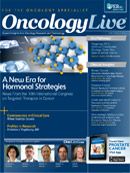Publication
Article
Oncology Live®
Redefining Standard-of-Care: In Rare Cancers, the Experiences of Two Patients May Be Enough
Author(s):
As more individual cancers undergo molecular profiling, we can anticipate that the scenario in which a targeted drug demonstrates rather remarkable clinical activity against a rare tumor type will become increasingly common.
Maurie Markman, MD
Editor-in-Chief of OncologyLive
Senior vice president for Clinical Affairs and National Director for Medical Oncology Cancer Treatment Centers of America, Eastern Regional Medical Center
The standard-of-care in the systemic antineoplastic management of a particular malignancy in a specific setting has in most circumstances been defined through the conduct of one or more phase III randomized trials. The primary study endpoint, generally either overall or progression-free survival, may necessitate the inclusion of hundreds or even thousands of patients to document, and will likely require a minimum of several years to complete.
Unfortunately, it is becoming increasingly difficult to conduct formal evaluations of the clinical benefits of all promising new agents or possible combination strategies where a strong rationale for their utility can be advanced. This is a particular concern in settings where there are limited numbers of patients potentially available for entry into so-called “evidence-based” (randomized) studies. In this scenario, well-designed and conducted single-arm phase II studies may be considered acceptable evidence by the general oncology community—even if not by regulatory agencies or third-party payers—for the strategy to be employed outside the realm of clinical investigative efforts.
But what happens in the setting of a well-defined but rare cancer where it is virtually certain the completion of even a moderately sized phase II clinical trial will take many years, assuming such a study could even be initiated? Is it appropriate in such a scenario to label a novel therapeutic strategy a new standard-of-care even if only a few patients have been documented as having achieved clearly unexpected but truly meaningful clinical responses?
Consider, for example, a recent report on the use of alemtuzumab in the management of two patients with metastatic histiocytic sarcoma, an extremely rare malignancy observed in both pediatric and adult populations.1 Histiocytic and dendritic cell neoplasms account for <1% of all lymph node and soft-tissue tumors, and histiocytic sarcoma is so rare that only 18 cases were identified in one of the largest worldwide studies of this class of hematopoietic malignancies.2-3
Histiocytic sarcoma is a cancer with biomarkers of histiocytic differentiation that has at times been confused with non-Hodgkin lymphoma. The malignancy can present and ultimately progress in rather poorly characterized patterns. Not surprisingly, there is currently no standard treatment beyond surgical resection. Radiation is employed for locally advanced or recurrent disease, and a variety of chemotherapeutic agents have been used in individual cases.
In a most provocative report, the cancers of two pediatric-aged patients with far-advanced histiocytic sarcomas who had failed standard chemotherapy options were found to contain cells that stained positively for the CD52 protein, an antigen known to be expressed on all lymphocytes. This particular analysis was undertaken in these patients based on prior knowledge that some histiocytic cells also had been shown to express CD52.
These provocative molecular findings led to the decision to treat both patients with alemtuzumab, a monoclonal anti-C52 antibody previously approved as a treatment for chronic lymphocytic leukemia. In one case, a 20-month-old child with extensive metastatic cancer achieved a complete response, which at the time of the current report had lasted for more than five years. The second patient, a 14-year-old girl who also had extensive disease, achieved a major response to therapy that lasted approximately nine months.
Thus, the question to be asked is: Based on the impressive clinical utility observed in these two patients with a rare chemotherapy-refractory malignancy, where a well-defined biomarker was present to suggest the biological activity of a particular antineoplastic, should this agent now be considered an acceptable standard of care? Further, should it become routine clinical practice in this most uncommon clinical setting to examine the tumor for the presence of CD52-positive cells?
While it is certainly acceptable to call for more study of alemtuzumab in the management of this rare malignancy, it also is highly reasonable—if not essential—to state clearly that this drug should be considered an appropriate standard-of-care treatment option in this unique clinical setting. Further, third-party payment for the cost of this drug should be approved, assuming the relevant biological target is demonstrated to be present in the individual patient’s cancer.
As more individual cancers undergo molecular profiling, we can anticipate that the scenario in which a targeted drug demonstrates rather remarkable clinical activity against a rare tumor type will become increasingly common. It will be important that an objectively rational strategy that focuses on the welfare of individual patients is developed both to test and subsequently pay for such therapeutic approaches.
- Shukla N, Kobos R, Renaud T, et al. Successful treatment of refractory metastatic histiocytic sarcoma with alemtuzumab [published online ahead of print December 13, 2011]. Cancer. 2012; 1189150:3719-3724. doi: 10.1002/ cncr.26712.
- Pileri SA. Dealing with the histiocytic neoplasms. Presented at: Society for Hematopathology Scientific Symposium, 2009 USCAP Annual Meeting; March 8, 2009; Boston, MA. http://www.uscap.org/index.htm?98th/companionhh.htm. Accessed September 25, 2012.
- Pileri SA, Grogan TM, Harris NL. Et al. Tumours of histiocytes and accessory dendritic cells: an immunohistochemical approach to classification from the International Lymphoma Study Group based on 61 cases. Histopathology. 2002;41(1)1-29.










